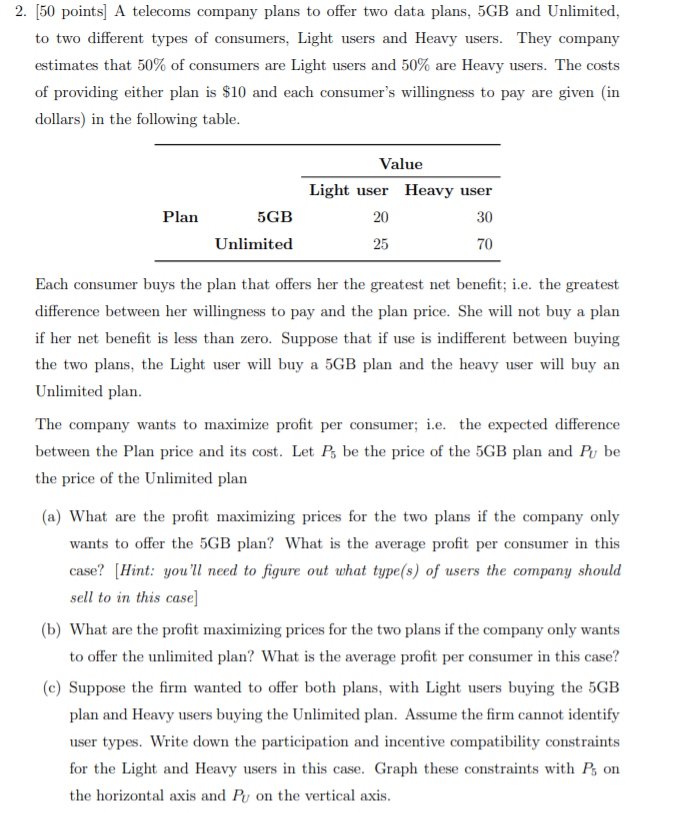
2. [50 points) A telecoms company plans to offer two data plans, 5GB and Unlimited, to two different types of consumers, Light users and Heavy users. They company estimates that 50% of consumers are Light users and 50% are Heavy users. The costs of providing either plan is $10 and each consumer's willingness to pay are given in dollars) in the following table. Value Light user Heavy user Plan 20 5GB Unlimited 30 70 Each consumer buys the plan that offers her the greatest net benefit; i.e. the greatest difference between her willingness to pay and the plan price. She will not buy a plan if her net benefit is less than zero. Suppose that if use is indifferent between buying the two plans, the Light user will buy a 5GB plan and the heavy user will buy an Unlimited plan. The company wants to maximize profit per consumer; i.e. the expected difference between the Plan price and its cost. Let P be the price of the 5GB plan and Pu be the price of the Unlimited plan (a) What are the profit maximizing prices for the two plans if the company only wants to offer the 5GB plan? What is the average profit per consumer in this case? [Hint: you'll need to figure out what type(s) of users the company should sell to in this case] (b) What are the profit maximizing prices for the two plans if the company only wants to offer the unlimited plan? What is the average profit per consumer in this case? (c) Suppose the firm wanted to offer both plans, with Light users buying the 5GB plan and Heavy users buying the Unlimited plan. Assume the firm cannot identify user types. Write down the participation and incentive compatibility constraints for the Light and Heavy users in this case. Graph these constraints with P, on the horizontal axis and Py on the vertical axis. 2. [50 points) A telecoms company plans to offer two data plans, 5GB and Unlimited, to two different types of consumers, Light users and Heavy users. They company estimates that 50% of consumers are Light users and 50% are Heavy users. The costs of providing either plan is $10 and each consumer's willingness to pay are given in dollars) in the following table. Value Light user Heavy user Plan 20 5GB Unlimited 30 70 Each consumer buys the plan that offers her the greatest net benefit; i.e. the greatest difference between her willingness to pay and the plan price. She will not buy a plan if her net benefit is less than zero. Suppose that if use is indifferent between buying the two plans, the Light user will buy a 5GB plan and the heavy user will buy an Unlimited plan. The company wants to maximize profit per consumer; i.e. the expected difference between the Plan price and its cost. Let P be the price of the 5GB plan and Pu be the price of the Unlimited plan (a) What are the profit maximizing prices for the two plans if the company only wants to offer the 5GB plan? What is the average profit per consumer in this case? [Hint: you'll need to figure out what type(s) of users the company should sell to in this case] (b) What are the profit maximizing prices for the two plans if the company only wants to offer the unlimited plan? What is the average profit per consumer in this case? (c) Suppose the firm wanted to offer both plans, with Light users buying the 5GB plan and Heavy users buying the Unlimited plan. Assume the firm cannot identify user types. Write down the participation and incentive compatibility constraints for the Light and Heavy users in this case. Graph these constraints with P, on the horizontal axis and Py on the vertical axis







